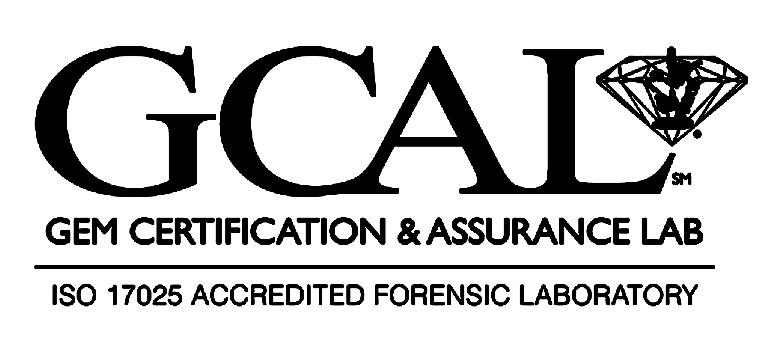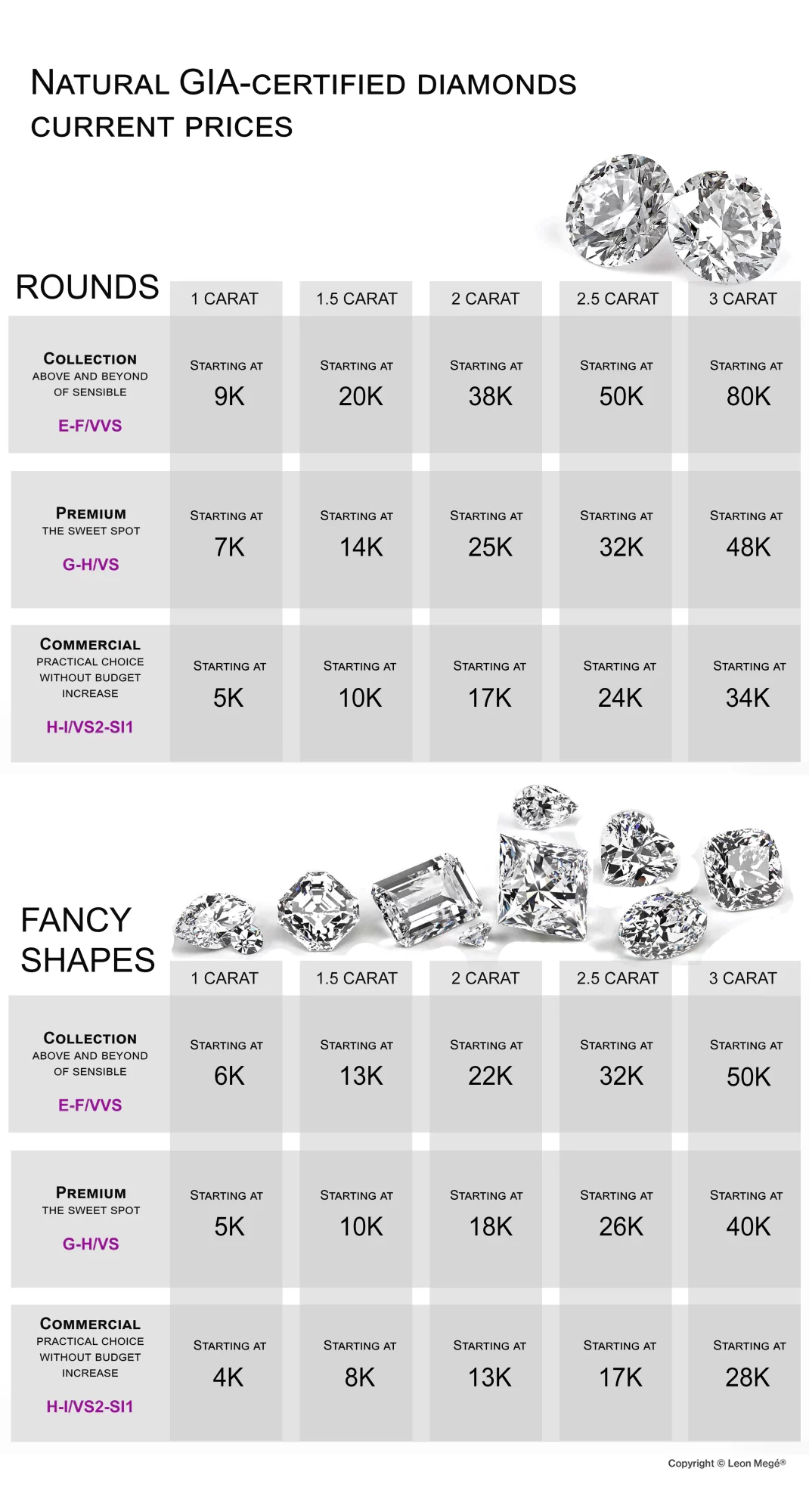- Guide to certification
- Diamond types

Honest jewelers sell only GIA certified diamonds.
Only a GIA grading report can establish a diamond’s real color, clarity, and value. Certificates from other labs should be taken with a grain of salt, and the diamonds should be submitted to GIA for re-evaluation and validation.
There is no government-mandated standard for diamond grading. The standards by which the grades are decided vary from lab to lab. For example, a GIA G-color diamond “graded” as an E-color at some lab can be easily misrepresented without legal repercussions because diamond grades are considered a subjective lab opinion. The astronomical price difference is very tempting for a jeweler with compromised integrity and lust for extra profit to sell diamonds with inflated grades to an unsuspecting consumer.
There are a few reputable gemological labs besides the GIA. However, the GIA is considered to be the gold standard for diamond grading. Any reputable jeweler or dealer will attest to that.
Gemological Institute of America (GIA)

The GIA is a giant of the gem world. Over 90% of diamonds are graded by its labs, which are spread worldwide. GIA grades set the standard by which all other labs attempt to operate. The GIA provides the only certification taken at its face value by members of the diamond trade. The GIA is not just a gem lab. It’s a research center as well as an educational institution. The GIA’s diploma program offers the most respected gemological degree in the world.
Full disclosure: Maestro Mege is a graduate of the Gemological Institute of America (class of 1991) and a member of the GIA Alumni Association.
- Full Diamond Grading Report for loose, D-to-Z color diamonds weighing 0.15 carats or more.
- Diamond Dossier® for loose, D-to-Z color diamonds weighing 0.15 -1.99 carats.
- Diamond eReport Online for loose D-to-Z color diamonds weighing 0.15 -2.99 carats.
- Diamond Focus™ Report online for select loose diamonds under 0.40 carats.
- It’s universal acceptance.
- Easy to compare and simple to understand the grading system.
- The diamond list price is based on a GIA grade.
- Ability to view and download a certificate online.
- Established reputable retailers sell only GIA-graded diamonds.
A diamond not accompanied by a GIA certificate has a significantly lower value on a secondary market. Buying a diamond not accompanied by a GIA certificate is a serious mistake that becomes apparent if, for whatever reason, you need to sell your diamond. A non-GIA certificate or an “in-house” appraisal will be laughed at by any serious buyer.
Primitive trade jargon of the past gave way to a universally accepted grading system developed by the GIA.
Letters from D to Z are assigned to color grades. Clarity grades are grouped into several tiers with abbreviated names – FL, VVS, VS, SI, and I.
HRD Antwerp
HRD strictly adheres to GIA grading standards and follows grading rules set by the International Diamond Council. HRD Antwerp grades are reliable and nearly identical to GIA. This well-respected lab was established in 1973 in Antwerp as the Diamond High Council at the initiative of the Belgian government and diamond industry representatives.
An HRD Antwerp “Natural Diamond Grading Report” confirms a polished diamond’s authenticity and key characteristics and even describes its carbon footprint. Their grading reports feature a microprint visible only in UV light, protecting it from counterfeits.
Swiss Gemmological Institute (SSEF)
The Swiss Gemmological Institute is a part of the Swiss Foundation for the Research of Gemstones (SSEF: Schweizerische Stiftung für Edelstein-Forschung) at the forefront of scientific innovation in gemology working independently on a scientific basis. The SSEF foundation was founded by trade organizations (UBOS: Union de la Bijouterie et Orfèvrerie Suisse) on August 22nd, 1972.
This lab’s grades are extremely reliable and usually taken at face value.
European Gemological Laboratory (EGL)
Effective October 1, 2014, EGL will no longer be listed as a diamond grading report on RapNet

EGL’s certificate is not worth the paper it’s printed on. The lab lost all of its credibility a long time ago. The stones graded by EGL are banned from trading networks.
An experiment conducted in 2008 resulted in EGL grading a one-carat K/SI1 diamond as G/VS1, a difference of more than 50% in value. Both the GIA and IGI had the diamond graded as K/SI1.
Diamond overgrading at EGL made news in 2014 when the decision was made to de-list all EGL diamonds from all diamond trading networks. The scandal reinforced the importance of maintaining grading standards and the need to report bad players.
American Gem Society (AGS)
The American Gem Society was founded in 1934 as a trade group of jewelers, appraisers, and dealers. AGS started to grade diamonds in 1996; the fact was omitted from all official publications. AGS bills itself as an established lab, but they are far from it.
AGS’s lax grading standards are despicable. They are neither reliable nor consistent. A diamond graded as G by AGS will likely be an I-color by the GIA standards. Some vendors actively exploit the resulting overgrading to increase their profit margin. A network of online trolls and fake bloggers are allegedly getting kickbacks for aggressively promoting the virtues of AGS stones.
More about the ASET scam by AGS exposed by Leon Mege. The ASET is a gizmo most professionals have never even heard of. Pure marketing with zero substance. An AGS grading report itself is designed to deceive. It shows the GIA grading scale, which falsely implies that the grades are compatible. They are certainly not.

International Gemological Institute (IGI)

The International Gemological Institute was established in 1975 in Antwerp. It has a relatively small impact on the diamond industry, particularly in the USA. Its certification is not overly reliable. However, IGI got an early start on grading lab-grown diamonds. The IGI certificate currently accompanies most lab-grown diamonds.
Gem Certification & Assurance Lab (GCAL)
GCAL was founded in 2001 in New York City. Since their share of certificates in the marketplace is negligible, there is no reliable data on their ability to grade stones according to universally accepted standards.

Central Gem Laboratory Co., Ltd. (CGL)

CGL is not Ceylon Gem Laboratory, not Colorado Genetics Laboratory, and not even Chanthaburi Gemological Laboratory. It’s Central Gem Laboratory Co., Ltd., located in Japan. The lab is hardly known outside of Japan. They do offer an online certificate check.
Gemological Science International (GSI)
Gemological Science International is an innovative lab with offices in India, Africa, and the US. Unfortunately, the only innovation is their VirtualVault™ or, in simple terms, a one-time fee of $35 for the right to access a picture of your certificate online.

Gem Studies Laboratory (GSL)

Gem Studies Laboratory was established in 1985 in Sydney, Australia. Established in the 21st century, GSI uses proprietary software to speed up procedures and delivery time, from basic diamond grading services to testing using advanced instruments. The lab generates several types of grading reports printed with differing formats, details, and educational material.
Diamond Certification Laboratory of Australia
A diamond certificate from Outback steakhouse carries more weight. Run for your life.


Diamonds are formed under high pressure in the middle layer between the surface crust and the central core of the Earth’s mantle. Most diamonds form at the base of the tectonic plates at depths of 80-120 miles. However, some rare “super-deep” diamonds originate deeper where the mantle slowly moves beneath the rigid and stable continental plates.
There are four diamond groups, but unlike the human assortment of blood types and rhesus factors, diamonds differ in their crystalline structure. Type II diamonds are the rarest and sought after by connoisseurs and collectors.
Type Ia diamonds contain clusters of Nitrogen atoms throughout the crystal structure. Those stones usually display some degree of yellow color. Nothing to write home about. These are the mainstream diamonds you typically see in jewelry.
Type Ib diamonds contain only Nitrogen atoms. These stones can have intense orange, brown, and sometimes green color.
Golconda diamonds
Type IIa, so-called Golconda diamonds, have no measurable impurities and lack Nitrogen in their crystal structure. They represent less than 2% of all-natural diamonds and are the most valuable. They are characteristically colorless, transparent, and exceptionally white. Colorless IIa diamonds are typically traced to the Golconda mine in India. Many famous diamonds are classified as Type IIa, including the Cullinan and Koh-i-Noor diamonds. Fancy-colored type IIa diamonds could be pink or purple.

Two thousand years before diamonds were discovered in Brazil and South Africa, the only source of diamonds in the world came from the Indian mines of Golconda. These famous mines are located near present-day Hyderabad and were named for the 14th-century Indian sultanate.
The “Golconda” designation suggests the stone’s origin can be traced to the historic mine. However, by the beginning of the 18th century, the mine had exhausted its supply of raw gems.
A disproportionate number of the world’s most famous diamonds came from Golconda; some of them are:
- The 105.6 carats (186 carats before a butchered attempt at re-cutting in 1852) Koh I Noor diamond adorning the Queen Mary’s crown during her 1911 coronation;
- The 410-carat Regent diamond – one of the last large diamonds to be found in India;
- The 70-carat Idol’s Eye, once paid in ransom by the sultan of Kashmir for the release of Princess Rashidah;
- The 32-carat Agra once adorned the Mughal emperor Babur’s turban;
- The 31-carats Wittelsbach, pawned to King Philip IV of Spain for the dowry of the Infanta Margarita Teresa
Type IIb diamonds contain traces of Boron within the crystal lattice. They are blue or blue/gray diamonds everyone is craving to collect. Boron-rich type IIb diamonds, such as the Hope diamond, are rare; less than 1 in a thousand is classified as type IIb. There has been uncertainty over whether “type IIb” diamonds larger than 3 carats formed in a shallow or deep environment.
- Type Ia encompasses roughly 98% of natural diamonds. They all have detectable traces of Nitrogen atom clusters. They are the most common type – 98% of all-natural diamonds.
- Type IIa and Type IIb stones are rare and usually sought after by connoisseurs and collectors.
- Are all D Flawless diamonds type IIa? Not necessarily, but most likely.



